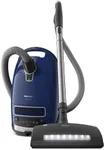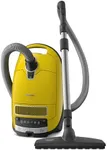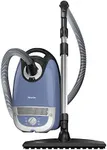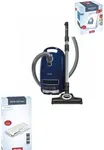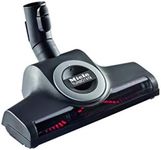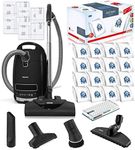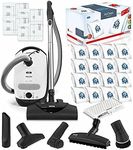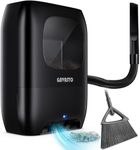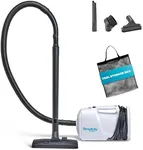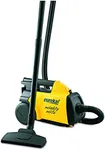Buying Guide for the Best Miele Carpet Vacuums
When choosing a Miele carpet vacuum, it's important to consider several key specifications to ensure you select the best model for your needs. Miele is known for its high-quality and durable vacuums, but different models offer various features that can make a significant difference in performance, especially on carpets. Understanding these specifications will help you make an informed decision and find a vacuum that fits your cleaning requirements perfectly.Suction PowerSuction power is a measure of how effectively a vacuum can pick up dirt and debris from your carpet. This is crucial for deep cleaning, especially if you have thick or high-pile carpets. Suction power is often measured in watts or air watts. Higher suction power means better cleaning performance, but it can also mean more noise and energy consumption. For homes with thick carpets or pets, a vacuum with higher suction power is recommended. For low-pile carpets or area rugs, moderate suction power should suffice.
Filtration SystemThe filtration system in a vacuum cleaner determines how well it can trap dust, allergens, and other particles. Miele vacuums often come with HEPA filters, which are highly effective at capturing tiny particles and are ideal for households with allergy sufferers. There are also AirClean filters, which are good for general use. If you or anyone in your household has allergies or asthma, a vacuum with a HEPA filter is a must. For general cleaning, an AirClean filter will be adequate.
Brush Roll TypeThe brush roll, or beater bar, is the part of the vacuum that agitates the carpet fibers to loosen dirt and debris. There are different types of brush rolls, including motorized and air-driven. Motorized brush rolls are more powerful and effective for deep cleaning, making them suitable for thick carpets and homes with pets. Air-driven brush rolls are less powerful but still effective for low-pile carpets and area rugs. Choose a vacuum with a brush roll that matches the type of carpet you have.
Adjustable Height SettingsAdjustable height settings allow you to change the height of the vacuum head to match the thickness of your carpet. This feature ensures optimal cleaning performance and ease of use. Vacuums with multiple height settings are versatile and can handle different carpet types, from low-pile to high-pile. If your home has a variety of carpet types, look for a vacuum with adjustable height settings to ensure thorough cleaning across all surfaces.
Weight and ManeuverabilityThe weight and maneuverability of a vacuum are important for ease of use, especially if you have a large home or multiple floors. Lighter vacuums are easier to carry and move around, but they may have less powerful motors. Heavier vacuums often have more powerful suction and larger dust capacities but can be more challenging to maneuver. Consider your physical capabilities and the layout of your home when choosing the weight and maneuverability of your vacuum.
Dust CapacityDust capacity refers to the amount of dirt and debris the vacuum can hold before it needs to be emptied. Larger dust capacities mean less frequent emptying, which is convenient for larger homes or extensive cleaning sessions. However, larger dust bins can also make the vacuum bulkier. If you have a large home or prefer less frequent maintenance, opt for a vacuum with a larger dust capacity. For smaller homes or lighter cleaning tasks, a smaller dust capacity will be sufficient.
Noise LevelThe noise level of a vacuum can affect your comfort while cleaning, especially if you have young children, pets, or sensitive ears. Noise levels are measured in decibels (dB), and lower numbers indicate quieter operation. Miele vacuums are generally known for their quiet operation, but some models are quieter than others. If noise is a concern for you, look for a vacuum with a lower decibel rating. For those who are less sensitive to noise, this may be a less critical factor.
